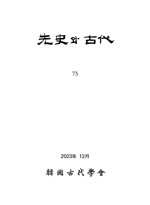- 영문명
- Reconsideration of the Neolithic·Bronze Age Cave tombs in Gangwon province of Korea
- 발행기관
- 한국고대학회
- 저자명
- 하문식(Moon-Sig Ha)
- 간행물 정보
- 『선사와 고대』78輯, 5~34쪽, 전체 30쪽
- 주제분류
- 인문학 > 역사학
- 파일형태
- 발행일자
- 2025.08.31
6,400원
구매일시로부터 72시간 이내에 다운로드 가능합니다.
이 학술논문 정보는 (주)교보문고와 각 발행기관 사이에 저작물 이용 계약이 체결된 것으로, 교보문고를 통해 제공되고 있습니다.

국문 초록
이 글은 강원 지역에서 조사된 춘천 교동 동굴, 영월 피난1·2굴, 영월 공기2굴, 정선 매둔 동굴을 통하여 신석기·청동기시대 동굴무덤에 관한 몇 가지를 살펴본 것이다.
신석기시대 동굴무덤의 무덤방은 특별한 시설을 하지 않고 동굴 바닥을 조금 파서 주검을 묻은 것으로 밝혀졌다. 묻기에 있어서는 세 사람이 다리를 가운데로 모으고 머리는 동굴 벽으로 향한 특이한 모습의 교동 동굴무덤이 주목된다. 피난1굴의 사람 머리뼈 겉면에서 조사된 자른 자국은 죽음을 인식시키는 의례와 관련이 있는 것으로 보인다. 또한 교동 동굴무덤에 껴묻기된 돌도끼는 일상 생활에 사용된 연장은 아니고 의도적으로 만든 것으로 울진 후포리 무덤이나 연해주 초로토비 보로타 동굴 유적의 자료와 비교된다.
신석기 동굴무덤에서는 유물 포함층에 여러 개체의 사람 뼈가 묻혀 있었다. 많게는 3개체부터 2개체가 조사되었는데 이것은 공동무덤의 성격을 지닌 것으로 여겨진다. 동굴무덤의 연대는 방사성탄소 연대 측정값의 눈금 연대로 보면 덧띠 토기가 발굴된 공기2굴이 가장 빠른 신석기 전기이고, 피난1굴의 Ⅳ층은 신석기 중기이다. 피난1굴의 Ⅲ층과 2굴의 Ⅱ층은 신석기 후기에 해당한다. 그리고 매둔 동굴은 신석기 후기의 끝자락으로 보인다.
청동기시대의 동굴무덤에서는 의도적으로 마련한 재층 위에 주검을 묻은 매둔 동굴무덤이 독특하다. 이것은 당시의 장례습속에 따른 정화의 과정으로 판단된다. 그리고 매둔 동굴에 묻힌 사람의 머리 방향은 동굴 앞으로 흐르는 지장천을 바라보고 있는데 이것은 절대적인 방위가 아니고 당시 사회의 생활 터전과 밀접한 관계가 있는 것으로 여겨진다. 피난2굴에서는 20대의 성인 왼쪽 아래턱 옆니에서 홈이 관찰되었다. 왕복과 수평적인 반복 행위로 생긴 이 홈의 단면은 U자 모양이고 실 잣는 행위와의 관련성을 시사한다.
껴묻거리를 통한 장례습속으로는 피난2굴 동굴무덤의 간 돌검 훼기 행위와 목 단지 안에 사람 머리뼈를 넣어 놓은 것, 피난2굴과 매둔 동굴무덤에서 찾아진 붉은 간 토기 등이 있다.
한편 신석기시대의 무덤에 주로 껴묻기된 투박조개로 만든 팔찌가 피난1·2굴과 매둔 동굴무덤에서 조사된 점도 특이하다. 남한강 상류의 내륙 지역에서 해수성 조개로 만든 팔찌가 찾아진 것은 동남해안 지역과의 교역 및 교류 관계를 시사한다.
청동기시대 동굴무덤의 연대는 방사성탄소 연대 측정값을 통한 눈금 연대로 보면 매둔 동굴은 BC 12~8세기이고, 피난2굴은 구멍무늬 토기와 목 단지로 볼 때 BC 9~8세기쯤에 해당된다.
영문 초록
This study analyzes neolithic and bronze age cave tombs excavated in the Gangwon province of Korea. The analysis focuses on the Gyodong Cave in Chuncheon, the Pinan Caves 1 and 2 in Yeongwol, the Gonggi Cave 2 in Yeongwol, and the Maedun Cave in Jeongseon.
The neolithic cave tombs buried shallow pits dug into the cave floors to place the corpse. Meanwhile, the Gyodong Cave tomb displays a unique arrangement in which three individuals were interred with their legs drawn together at the center and their orientation of the head toward the cave walls. Cut marks identified on the outer surface of a human skull from Pinan Cave 1 are interpreted as evidence of rituals associated with the recognition of death. The polished stone axes included as a funerary objects in the Gyodong Cave tomb were not a utilitarian tool but appears to have been deliberately crafted for burial purposes.
The presence of multiple human bones within the artifact-bearing layers of the neolithic tombs suggests these were communal burials. Radiocarbon dating indicates that Gonggi Cave 2 dates to the early neolithic, while Layer IV of Pinan Cave 1 corresponds to the middle neolithic. Layer III of Pinan Cave 1 and Layer II of Cave 2 belong to the late neolithic, and the Maedun Cave is dated to the final stage of the neolithic period.
Among the bronze age cave tombs, the Maedun Cave features a distinct practice where the corpse was laid upon a deliberately prepared ash layer, possibly reflecting a purification ritual in accordance with contemporary funerary customs. The orientation of the head toward the Jijeong Stream flowing in front of the cave is also notable. In Pinan Cave 2, a groove was observed on a molar beside the left mandible of a young adult, with its U-shaped cross-section suggesting it was related to spinning thread.
Funerary practices include the domolishing of a polished stone dagger, the placement of a human skull inside a jar in Pinan Cave 2 and the presence of burnished red pottery in both Pinan Cave 2 and the Maedun Cave tomb.
Bracelets made of Glycymeris albolineata often found as funerary objects in neolithic tombs, were also excavated in Pinan Caves 1 and 2 and the Maedun Cave tomb. The presence of these bracelets—crafted from marine shells—in the inland upper reaches of the Namhan River implies trade or exchange with communities along Korea’s southeastern coast.
Radiocarbon dating places the Maedun Cave tomb in the 12th to 8th centuries BCE. The Pinan Cave 2 tomb dates to approximately the 9th to 8th centuries BCE.
목차
Ⅰ. 머리말
Ⅱ. 신석기시대 무덤
Ⅲ. 청동기시대 무덤
Ⅳ. 동굴무덤의 성격
Ⅴ. 맺음말
참고문헌
키워드
해당간행물 수록 논문
참고문헌
교보eBook 첫 방문을 환영 합니다!

신규가입 혜택 지급이 완료 되었습니다.
바로 사용 가능한 교보e캐시 1,000원 (유효기간 7일)
지금 바로 교보eBook의 다양한 콘텐츠를 이용해 보세요!



